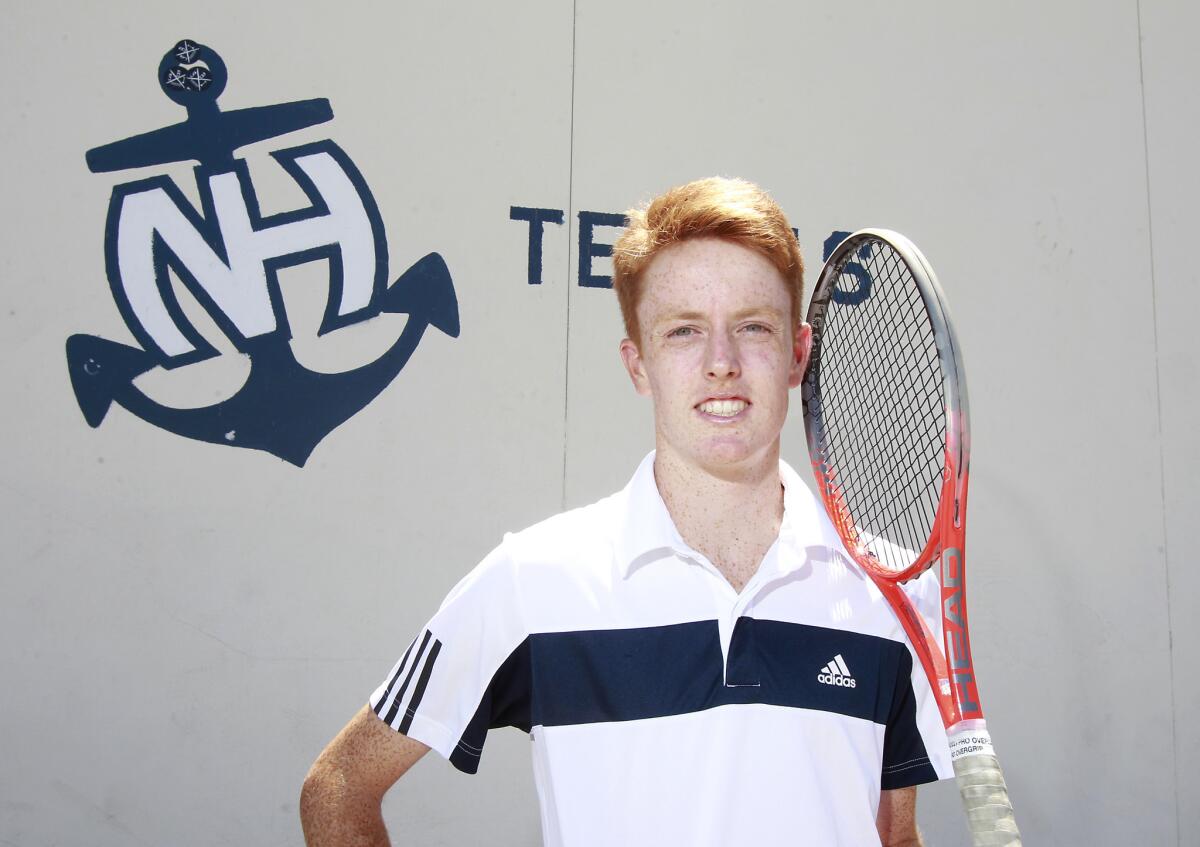Boys’ Tennis: Stalder making moves for Sailors

- Share via
Reese Stalder earns respect on the tennis court, not only for his big serve and great hands but also for the way that he plays the game.
Stalder is not one of those players who calls every close ball “out.” But if his opponent is doing so, he also is not one to over-react and make a scene.
The Newport Harbor High junior is steady and calm on the court. His face never gets as red as his hair.
He has simply been a rock at No. 1 singles for the Sailors over the past three years, a great role model for his peers.
“He lets his racket do the talking,” Newport Harbor Coach Kristen Case said. “He’s not flashy and loud. He just really gets out there and plays with class and is very humble, which I know that everybody on the team, as well as myself, really admires. He respects all of his opponents. Sometimes you don’t find that with somebody at his level, but he respects everybody he plays.”
Stalder continues play in the CIF Southern Section Individuals singles tournament on Friday at 11:30 a.m., at Seal Beach Tennis Center. He has made it to the round of 16, the only Newport-Mesa player to get this far.
Whatever the results this weekend, Stalder will handle the situation with class. Part of the reason for that is that kind of sportsmanship has been drilled into him from a young age. His father, Curt, who is now in real estate, played tennis at UC Irvine. He helped the Anteaters claim the 1977 NCAA Division II title, the same year he won the Division II doubles title with partner Jeff Williams.
That was a good year for the family. Also in 1977, Reese’s mother Diane, now a lawyer, helped USC win the women’s national title. Both parents also played professionally, with Diane reaching as high as No. 32 in the world in singles. Then known as Diane Desfor, she reached the doubles quarterfinals at the U.S. Open and Wimbledon.
“They know the commitment that it requires,” said Reese, who started playing at Newport Beach Tennis Club and was entering tournaments by the age of 7. “So they pushed me to take it seriously.”
Curt and Diane tend to stay behind the scenes in the careers of Reese and his older sister Samantha, who had a good freshman season playing at Bowdoin College in Maine. Some parents get worked up during the matches, even more than the kids, but you won’t find that with the Stalders.
“We tried to keep a little distance at times, and get them other instructors, rather than using ourselves,” Diane Stalder said. “We weren’t always good at keeping that arm’s length distance, but obviously we were thrilled when both kids seemed to like it. They really made the choice to stick with it. I think having parents play is both a blessing and a curse. I’m sensitive of that. My dad was quite involved, for good and for bad, when I was growing up.
“We had the attitude that there’s a lot of matches coming up in their future. One single match isn’t going to make or break them. It’s hard to get that perspective sometimes.”
Reese said he played his dad in a few sets when he was 11 or 12, really just starting out in the sport. Curt always won. Now there’s little doubt that outcome would be reversed.
One thing that Reese may have gotten from his dad is his great hands at the net. Reese always has been a great doubles player. Last summer, he and former CdM player Henry Gordon placed third at the United States Tennis Assn. Junior National Hard Court Championships in Kalamazoo, Mich. At the Southern California Junior Sectionals, he and Gordon made the quarterfinals in 2012, while Stalder and Austin Rapp narrowly lost in the round of 16 last year. Stalder has been ranked No. 1 in the Southern California 16s in doubles.
But now Stalder, who had mixed results in the 12s and 14s, is stepping it up quite a bit in singles as well. He’s ranked No. 9 in Southern California in the 18s and won a big tournament in April, the Harper Ink in San Diego. He appears to be all the way back physically from an abdominal strain, a reoccurring injury that he aggravated at the Easter Bowl.
In the high school season, he was the Sunset League runner-up after losing a tough title match to Riley Smith of Los Alamitos. But Stalder was more than happy to finish second in league and qualify for CIF Individuals for the first time, after falling in the tournament semifinals each of his first two years.
Stalder was 43-3 during the regular season, helping the Sailors again finish third in the tough league as a team and advance to the CIF Southern Section Division 1 playoffs.
“I think it’s mainly increased patience,” he said. “I’m willing to stay out there a lot longer. If Plan A doesn’t work I can rely on Plan B, as opposed to if Plan A doesn’t work just keep trying things that won’t work. I used to be really impatient and just go for shots that were so stupid, go for winners for nothing. [Now] I’m willing to wait for a good opportunity.”
CdM boys’ tennis coach Jamie Gresh saw a good opportunity when he was asked to be Stalder’s private coach in August, 2011. They have worked on making Stalder’s serve a bigger weapon, which has set up the rest of his game nicely. The increased power, combined with Stalder’s willingness to come into net and his proficiency when he gets there, have equaled a better singles game.
“If his serve’s clicking, then the game’s on all cylinders,” Gresh said. “When it’s on, he’s setting up his points nicely. He’s getting at lest one freebie a game, in terms of an unreturnable [serve] or an ace. If it’s not, he’s got to realize that he’s got to work the point a little more thoroughly and not rush things ... His game has just grown exponentially. He’s just a really easy kid to work with, in the sense of his listening skills and what he puts into it. He really absorbs everything that I’m talking about and we have a good relationship, a back and forth of what he needs to do out there.”
Stalder is often at CdM hitting with Gresh, but sometimes he hits at Newport Harbor too. One day a week, he said he goes to Advantage Tennis Academy in Irvine. However, that’s not his life. He doesn’t take schooling through Advantage, as some other top junior players do.
“I’m personally glad I never did that,” he said. “I’m glad I met my friends at school that I wouldn’t have had a chance to meet if I didn’t go to school. I’m glad I stayed on the path of more conventional [schooling]. My parents, I doubt they would have let me, even I wanted to.”
The chance is there for Stalder to keep going at CIF Individuals. Of the eight players ranked ahead of him in the 18s, just three — Harvard-Westlake’s Michael Genender, Palm Desert’s Rapp and Daniel Gealer of San Marino — will be playing at Seal Beach. Still, there are other tough players like Tracy Austin’s son Brandon Holt of Palos Verdes, University High’s Drew Dawson and Stefan Doehler of Foothill in the mix.
It’s tough competition, and emotions could run high. But Stalder remains grounded. One thing the Stalders know is that junior tennis is a close-knit community.
“Curt and I know that we made lifelong friends through junior tennis,” Diane Stalder said. “We did emphasize to the kids their behavior on the court, and being fair. You are playing against your friends. They don’t have to be your mortal enemies. There are some coaches that don’t teach that.”
